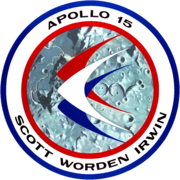
Back Apollo 15 Afrikaans أبولو 15 Arabic Apollon 15 Azerbaijani Апалон-15 Byelorussian Аполо 15 Bulgarian অ্যাপোলো ১৫ Bengali/Bangla Apollo 15 Catalan Apollo 15 Czech Apollo 15 Welsh Apollo 15 Danish
 Jim Irwin salutes the United States flag on the Moon, August 1, 1971 | |
| Mission type | Crewed lunar landing |
|---|---|
| Operator | NASA[1] |
| COSPAR ID |
|
| SATCAT no. |
|
| Mission duration | 12 days, 7 hours, 11 minutes, 53 seconds[3] |
| Spacecraft properties | |
| Spacecraft |
|
| Manufacturer |
|
| Launch mass | 48,599 kilograms (107,142 lb) |
| Landing mass | 5,321 kilograms (11,731 lb)[6] |
| Crew | |
| Crew size | 3 |
| Members | |
| Callsign |
|
| EVAs | 1 in cislunar space and 4 on the lunar surface[7] |
| EVA duration | 39 minutes, 7 seconds[7] Spacewalk to retrieve film cassettes |
| Start of mission | |
| Launch date | July 26, 1971, 13:34:00.6 UTC[8] |
| Rocket | Saturn V AS-510[9] |
| Launch site | Kennedy LC-39A |
| End of mission | |
| Recovered by | USS Okinawa[3] |
| Landing date | August 7, 1971, 20:45:53 UTC[3] |
| Landing site | North Pacific Ocean 26°7′N 158°8′W / 26.117°N 158.133°W[3] |
| Orbital parameters | |
| Reference system | Selenocentric[10] |
| Periselene | 101.5 kilometers (54.8 nmi)[10] |
| Aposelene | 120.8 kilometers (65.2 nmi)[10] |
| Inclination | 23 degrees[10] |
| Epoch | July 30, 1971[10] |
| Lunar orbiter | |
| Spacecraft component | Command and service module |
| Orbital insertion | July 29, 1971, 20:05:46 UTC[7] |
| Orbital departure | August 4, 1971, 21:22:45 UTC[7] |
| Orbits | 74[11] |
| Lunar lander | |
| Spacecraft component | Lunar module |
| Landing date | July 30, 1971, 22:16:29 UTC[7] |
| Return launch | August 2, 1971, 17:11:23 UTC[7] |
| Landing site | 26°07′56″N 3°38′02″E / 26.1322°N 3.6339°E[12] |
| Sample mass | 77 kilograms (170 lb)[3] |
| Surface EVAs | 4 (including standup) |
| EVA duration | |
| Lunar rover | |
| Distance covered | 27.9 kilometers (17.3 mi)[3] |
| Docking with LM | |
| Docking date | July 26, 1971, 17:07:49 UTC[7] |
| Undocking date | July 30, 1971, 18:13:16 UTC[7] |
| Docking with LM Ascent Stage | |
| Docking date | August 2, 1971, 19:10:25 UTC[7] |
| Undocking date | August 3, 1971, 01:04:01 UTC[7] |
| Payload | |
| |
| Mass |
|

 Left to right: Scott, Worden, Irwin | |
Apollo 15 was the ninth crewed flight of NASA's Apollo program. It was the fourth mission to land on the surface of the Moon and the first J-Type mission. Apollo 15 was launched on July 26, 1971.[16]: 77 Alfred Worden stayed in orbit in the Command Module, Endeavour, while the Lunar Module, Falcon, landed at Hadley Base, with David Scott and James Irwin. The astronauts used the first Lunar Roving Vehicle to travel on the Moon.[17] This vehicle was specially designed to work in a vacuum, with a wide range of temperatures across rough ground. They travelled a distance of 17.5 mi (28 km) on the Moon.[18] They spent three days (66 hours, 55 minutes) on the Moon. They were able to collect a lot of rock samples, including a core sample from at least 10 ft (3 m) deep.[18]
- ↑ Orloff, Richard W. (September 2004) [2000]. "Table of Contents". Apollo by the Numbers: A Statistical Reference. NASA History Series. Washington, D.C.: NASA. ISBN 978-0-16-050631-4. Archived from the original on August 23, 2007. Retrieved July 18, 2009.
- ↑ 2.0 2.1 2.2 "Apollo 15 Lunar Module /ALSEP". NASA Space Science Data Coordinated Archive. Retrieved March 8, 2019.
- ↑ 3.0 3.1 3.2 3.3 3.4 3.5 Mission Report, p. 3.
- ↑ "Apollo 15 Command Module". Smithsonian Air and Space Museum. March 17, 2016. Archived from the original on July 22, 2019. Retrieved January 29, 2019.
- ↑ "Lunar Module LM-2". Smithsonian Air and Space Museum. March 21, 2016. Archived from the original on January 15, 2020. Retrieved March 7, 2019.
- ↑ Mission Report, p. 263.
- ↑ 7.00 7.01 7.02 7.03 7.04 7.05 7.06 7.07 7.08 7.09 7.10 7.11 Orloff, Richard W. (September 27, 2005) [2000]. "Apollo 15 timeline". Apollo by the Numbers: A Statistical Reference. NASA History Series. Washington, D.C.: NASA. ISBN 978-0-16-050631-4. Retrieved January 29, 2019.
- ↑ Mission Report, p. 1.
- ↑ Orloff & Harland, p. 426.
- ↑ 10.0 10.1 10.2 10.3 10.4 Mission Report, pp. 10–11.
- ↑ 11.0 11.1 Orloff, Richard W. (September 27, 2005) [2000]. "Apollo 15 The Ninth Mission: The Fourth Lunar Landing 26 July-7 August 1971". Apollo by the Numbers: A Statistical Reference. NASA History Series. Washington, D.C.: NASA. ISBN 978-0-16-050631-4. Retrieved January 29, 2019.
- ↑ "NASA NSSDC Master Catalog – Apollo 15 LM descent stage". NASA Space Science Data Coordinated Archive. Archived from the original on February 19, 2017. Retrieved January 6, 2019.
- ↑ Mission Report, p. 15.
- ↑ Mission Report, pp. 15–16.
- ↑ Mission Report, p. 16.
- ↑ Furniss, Tim (2001). The History of Space Vehicles. London: Grange Books. ISBN 1-84013-370-8.
- ↑ Lang, Kenneth R. (2011). The Cambridge Guide to the Solar System (Second ed.). Cambridge University Press. p. 172. ISBN 978-0-521-19857-8.
- ↑ 18.0 18.1 "NASA - Apollo 15". nasa.gov. 2009. Retrieved August 11, 2012.